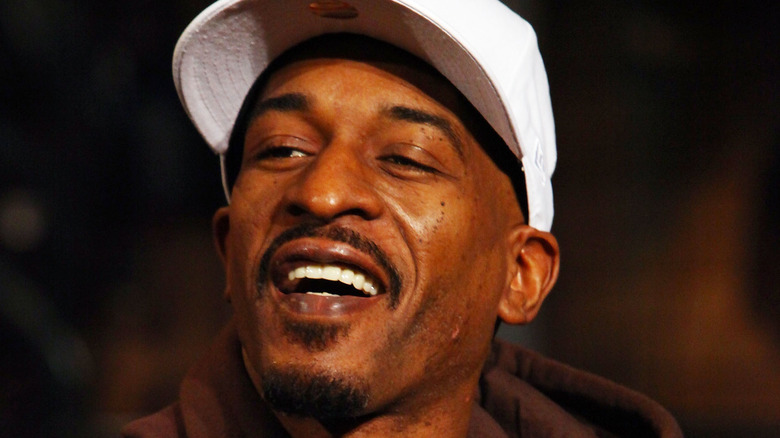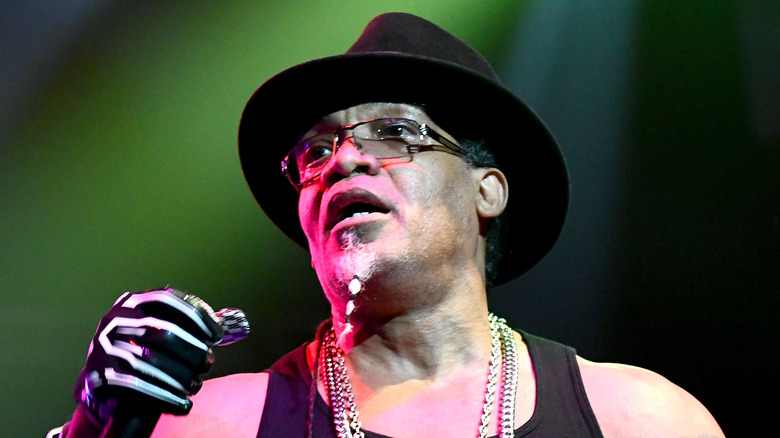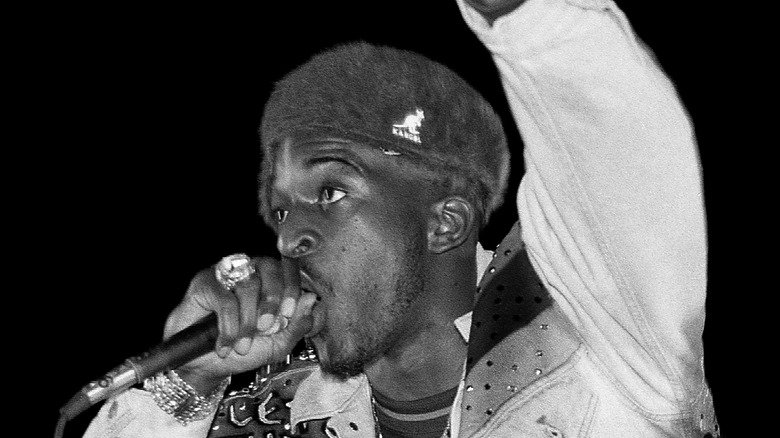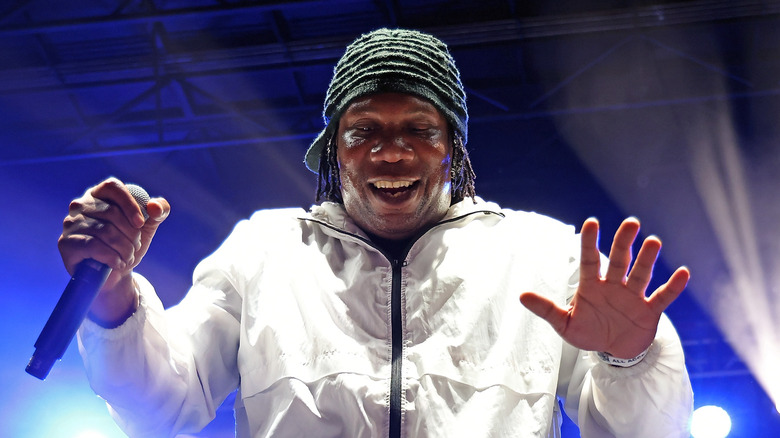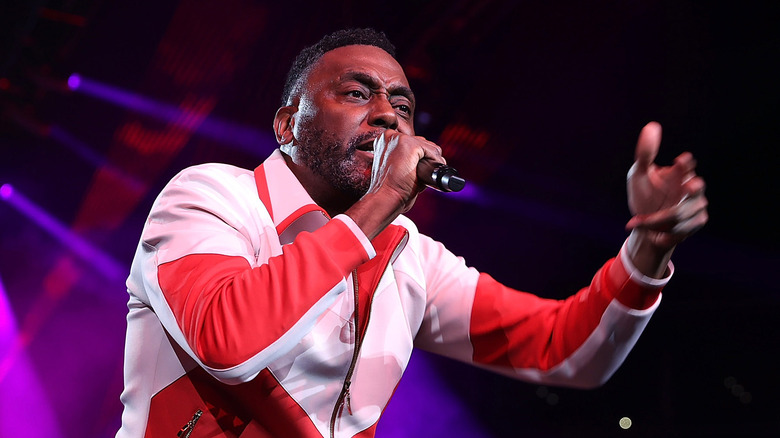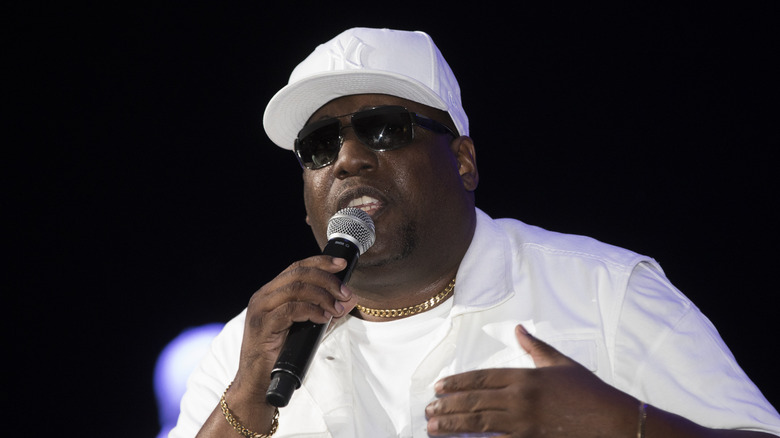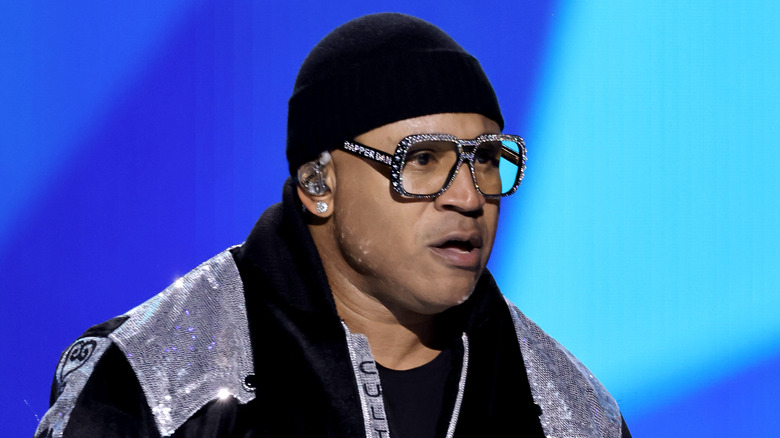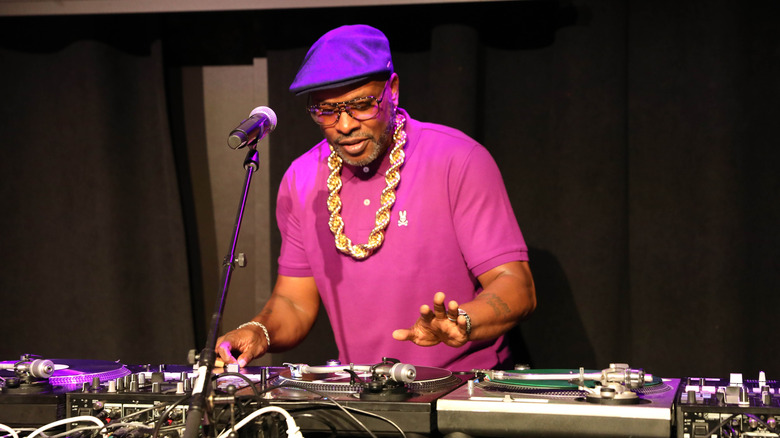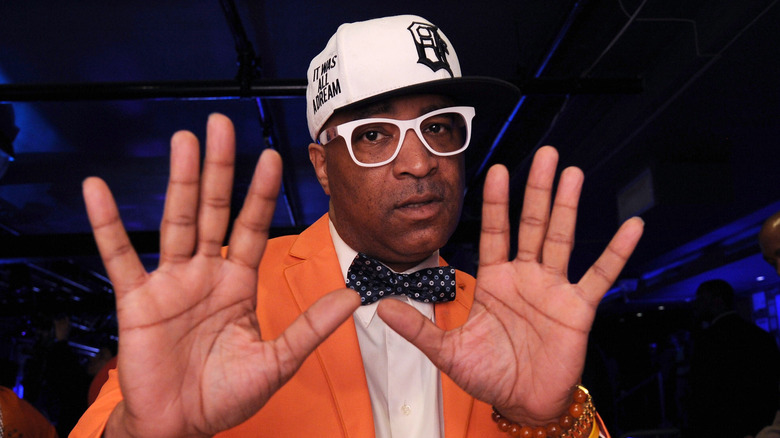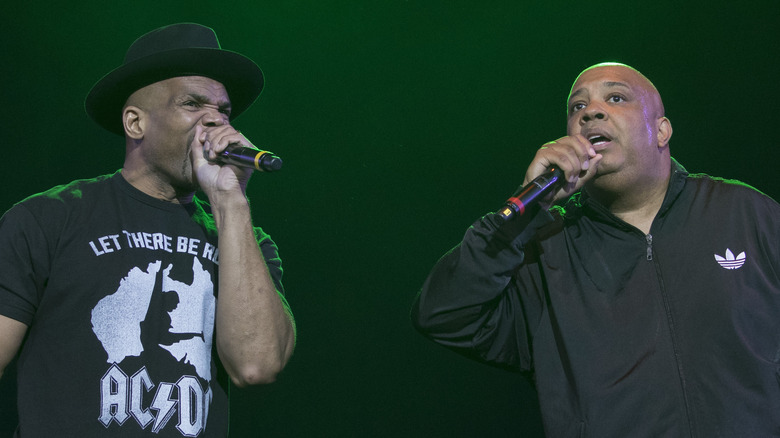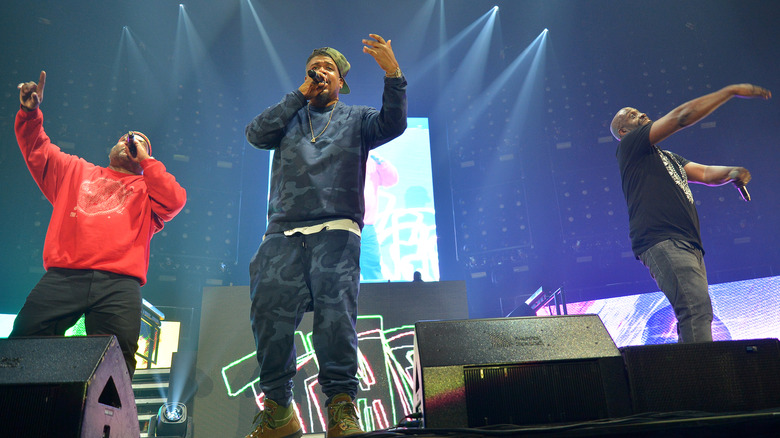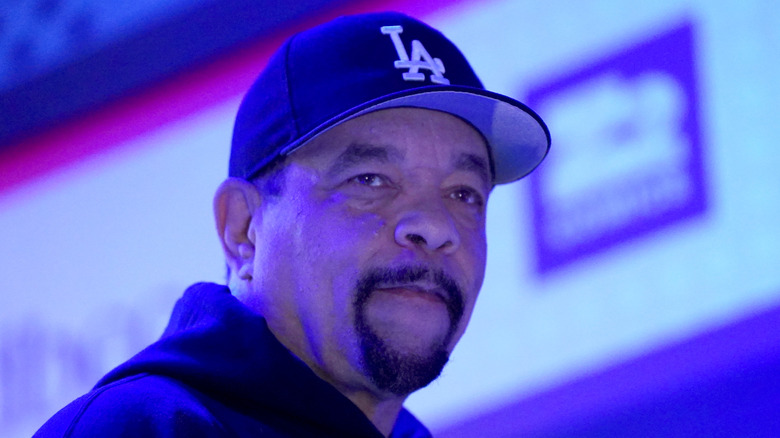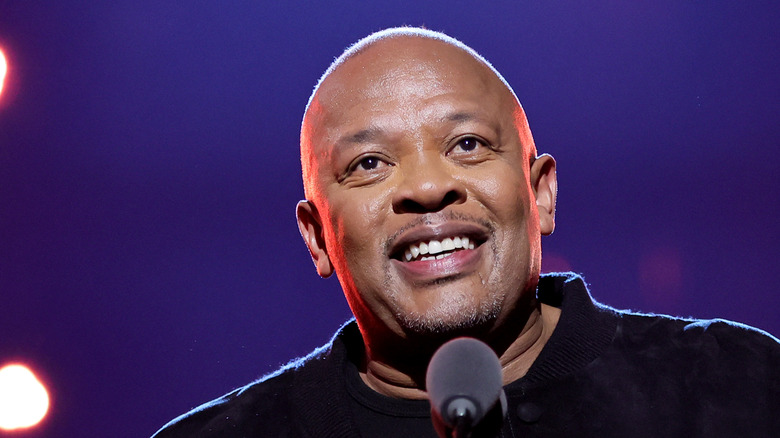The Most Influential Artists Of Hip-Hop's Golden Age
The "Golden Age of Rap" is loosely defined as the period between 1986 and 1993, give or take a couple of years on either side, as noted by the Chicago Tribune. Like most golden ages, it was characterized by explosive growth, both creatively and in terms of its place in the popular consciousness, and to this day, it led to some of the most innovative, groundbreaking, and ... well, funky fresh tunes in all of popular music. Rap's golden age swiftly and definitively washed away the disco influences that preceded it: First, it established a hard-edged, drum machine-driven sound, before giving way to a nearly limitless sonic palette in which a grab bag of musical influences could live comfortably side-by-side on the same song.
It was an era in which new ground was broken seemingly daily, and the artists featured here were the ones holding the biggest shovels. They were more than just innovators; all of them took the music to places nobody ever had before, and if you love rap, you owe each of them a debt of gratitude. Here are the most influential artists of hip-hop's golden age
Grandmaster Melle Mel
Melvin Glover — the MC known as Grandmaster Melle Mel — was the lead rapper for Grandmaster Flash and the Furious Five — a supergroup of sorts that came into existence years before rap was even a recorded form. According to a video essay from hip-hop historian JayQuan (via YouTube), Mel was just about the most potent rapper of the early '80s, possessed of a booming, authoritative voice and a level of technical skill that few could match.
Although his heyday was technically before the start of the golden age, Mel helped to shape it in two important ways. First, his willingness to embrace social issues — exemplified by the monster classic "The Message," which the other members of the Furious Five famously wanted nothing to do with, per The Guardian — was nonexistent among his peers when that song was released in 1982.
Second, his ability to cross genre lines would serve as an example to those who followed him. Per Slant, in 1984, long before any other MC of his stripe sniffed mainstream success, his guest vocal drove Chaka Khan's bouncy, Prince-penned single "I Feel For You," propelling the tune to No. 3 on the pop chart (via Billboard) and two Grammy Awards (via AllMusic). On top of these accomplishments, Mel was simply a great vocalist and lyricist. His style was nimble, yet muscular and commanding, with lyrics as insightful and poetically informed as many of his peers' were simplistic.
Rakim
If you're not familiar with the work of William Griffin III, also known as Rakim, you may be puzzled as to why he's often referred to as the "God MC," or why he's regularly posited as the greatest rapper of all time, as described by hip-hop historian JayQuan (via YouTube). Well, it's simple: Along with a handful of others, Rakim ushered the rhyme flow into the modern age, opening up a new world of possibilities for the form.
In an interview with Salon, Rakim revealed how his relaxed, jazzy flow — miles away from the near-shouted, rhythmically simple rhymes of his peers — was informed by his family's love for jazz. There was also the fact that he had to be a little quiet practicing his rhymes in his room — he dropped his first single and took part in his first tour, he says, at the age of 17.
Along with his disarmingly fluid delivery, Rakim helped to pioneer the use of internal and multisyllabic rhyme schemes (via NPR), techniques that were not in widespread use before him, but which began to come into vogue after he came on the scene. The inspiration for his flow came not from his fellow rappers, but from instrumentalists like the legendary saxophonist John Coltrane — and his very first single, 1986's "My Melody" (per AllMusic), made everyone else look behind the times by comparison.
KRS-One
Lawrence "Kris" Parker is better known as KRS-One: The former graffiti artist was a teen runaway, and was living in a homeless shelter when he hooked up with one the shelter's counselors — Scott Sterling, who took on the moniker DJ Scott La Rock to form the Bronx crew Boogie Down Productions along with KRS and D-Nice (via Frank).
The contributions of KRS are many; he was at the center of the infamous "Bridge Wars" between BDP and Queens' Juice Crew, one of rap's first high-profile beefs. He was also among the first to fuse rap with Jamaican dancehall reggae (via New York Times), a style he debuted to devastating effect on "The Bridge is Over," BDP's second volley in said beef. But his greatest contribution was to the form itself. The rapid-fire style and dizzying rhyme schemes he employed on tracks like "Poetry," the opening tune on BDP's 1987 debut album "Criminal Minded," were unlike anything that came before. In later years, his level of technical skill (not to mention his freestyle chops) would approach the otherworldly.
Big Daddy Kane
Among the greatest of paradigm-shifting golden age lyricists is Antonio "Big Daddy Kane" Hardy, whose 1988 debut album "Long Live the Kane" (via Discogs) solidified the fluid, complex style that Rakim and KRS-One had introduced. As noted by the Chicago Tribune, Kane's influence went far beyond the technical; while he could assert his lyrical dominance with the best of his peers, he was equally prone to rhyme about social issues, Black pride, and his prowess with the ladies. (Kane was a famously handsome man, even making an appearance in Madonna's infamous 1992 book "Sex," per Rock the Bells.)
The Tribune notes that no less of a wordsmith than Eminem name-dropped Kane during a Grammy acceptance speech, and it wasn't the first time. On his 2004 track "Yellow Brick Road," Eminem rapped of himself and his longtime partner Proof: "We was on that same s***, that Big Daddy Kane s*** / Where compound syllables sound combined" (via Genius). Kane also had a degree of crossover success, with his 1989 sophomore effort "It's a Big Daddy Thing" and his 1990 release "A Taste of Chocolate" breaching the Top 40 (via Billboard) — but among technical rap fiends, he'll also be known as perhaps the fastest rapper alive in his heyday (via Chicago Tribune). He was dazzlingly adept at combining fast tempos with ridiculous quantization to spit faster than virtually anyone else, as heard in the opening salvo from his 1991 single "Nuff Respect."
Kool Moe Dee
Beginning his career with his group the Treacherous Three before rap became a recorded form, Mohandas "Kool Moe Dee" Dewese was one of the rappers from the preceding era to successfully transition to the golden age, per AllMusic. He achieved a minor mainstream hit single with "Wild Wild West" from his 1987 sophomore album "How Ya Like Me Now" (via Billboard) and displayed technical and rhyming skills on par with the pioneers he shared the airwaves with. His real contribution to the golden age and beyond, though, came in 1981 — during an event at the legendary Harlem World nightclub, where he introduced the world to battle rapping as we know it.
As outlined in a segment in the amazing documentary "Beef," MC battles to this point consisted of simply competing to see who could rock the crowd the hardest. Moe Dee had other ideas when the reigning champ, MC Busy Bee Starski, simply would not quit running his mouth before the contest. Originally set only to host the event, not compete, Moe Dee had his name put on the list — then proceeded to issue the most brutal takedown of a competitor that anyone had seen at that time, mocking Busy Bee's simplistic delivery along with a few insults of a more personal nature. In the documentary, KRS-One describes how bootleg tapes of the battle dropped like a nuclear bomb across the five boroughs, and battle rapping has never been the same since.
LL Cool J
We all know him, we all love him, especially the ladies: James Todd "LL Cool J" Smith has become a pop culture icon in the years since his debut release, "Radio," dropped all the way back in 1985, per Discogs. (Incidentally, that album was among the very first to be produced by another future legend, sporting the hilarious credit "Reduced by Rick Rubin," per AllMusic.) But his influence lies in his effortless crossover ability (via MTV), which began with a pair of ballads, among rap's first ever, on that very album.
For his second LP, 1987's "Bigger and Deffer," LL perfected his formula: Loudmouthed, technically adept braggadocio for the fellas ("The baddest rapper in the history of rap itself," he oh-so-humbly proclaimed himself on lead single "I'm Bad"), and smooth love jams for the ladies. The album's second single, the simply-titled "I Need Love," shot to No. 14 on the Hot 100 (via Billboard), establishing LL as an MC who could emote, as well as kick butt, with the best of them. He'd continue the trend throughout his career, paving the way for all of the hip-hop-R&B crossovers to follow — but the dichotomy between his Badass and Loverman personas didn't always sit well with his peers. LL was also among the first to regularly engage in high-profile exchanges of diss tracks, most notably with Kool Moe Dee.
DJ Jazzy Jeff
Jeff "DJ Jazzy Jeff" Townes is well-known as one-half of one of the most commercially successful rap acts of the golden age, along with some guy named the Fresh Prince, per AllMusic. His crossover success alone would make him a pioneer; DJ Jazzy Jeff and the Fresh Prince won the first-ever Grammy for a rap song (via The New York Times) for their 1988 single "Parents Just Don't Understand," and the pair have notched no fewer than five Top 40 singles (via Billboard). But here's what you may not know: Jeff is regarded by those in the know as one of the greatest pure DJs of all time, and without an innovation he co-created, the entire turntablist movement of the '90s might not have happened.
That technique? The "Transformer Scratch," which replaced the crossfader on the DJ's mixer with a momentary switch that allowed the volume to cut in and out cleanly. Tapping the switch while moving the record in a rhythmic fashion resulted in a sound not unlike Optimus Prime turning into a truck, which is how the technique came by its name. Jeff pioneered this along with a handful of others (via PBS), and in an interview with The Cut, famously skilled turntablists DJ Q-Bert and DJ Revolution cited his first recorded use of it (on 1987's "The Magnificent Jazzy Jeff") as a huge influence on them. He may be most famous for getting chucked out the door by Uncle Phil, but Jeff is one of the best to ever touch a turntable.
DJ Marley Marl
In the years immediately preceding the golden age, rap was a largely drum machine-based form. When early samplers became available, producers began to experiment with looping phrases of instrumentation behind their beats — but it took a happy accident for one producer, Juice Crew mastermind Marlon "Marley Marl" Williams, to take it to the next level (per AllMusic). In an interview with NPR, Marley described how, while trying to sample a riff from a record in the studio one day, he happened to catch a piece of the snare. When looped, it augmented the sound of the drum machine nicely — and a light bulb went off in Marley's head.
He began collecting more individual drum sounds and using them to assemble his beats, rather than the inorganic, artificial sounds from the drum machine. It was a technique that, when combined with the sampling capabilities of the then-new Emu SP-1200 drum machine-slash-sampler, brought a richness and fullness to Marley's tracks that had previously been impossible to achieve. Marley's innovation would be a heavy influence on such legendary producers as the Wu-Tang Clan's RZA, Gang Starr's DJ Premier (via Industry Rules), and Pete Rock, who told Village Voice in 2007 that Marley's work with the unit inspired him to get his hands on one. "I used it all day, every day," he said. "I never came outside ... I didn't give a damn about anything else once I got that drum machine."
Run-DMC
Even non-fans are likely to know that Run-DMC were, along with the Beastie Boys, the first rappers to achieve major mainstream success. Their third album, 1986's "Raising Hell," sold a gazillion copies, revitalized the career of Aerosmith (who guested on the album's smash cover of "Walk This Way," per The Guardian), and introduced hardcore rap to a wide audience — but it's difficult to overstate the extent to which, even before that album dropped, Run-DMC simply changed everything.
As noted by OkayPlayer, the group was unapologetically mixing rap with rock as far back as their 1984 self-titled debut album and its single "Rock Box." Their fashion aesthetic — jeans, leather jackets, Stetson hats — was about as far as one could get from the flamboyant, disco-influenced fashion of rappers past. Their musical style, mainly consisting of near-shouted vocals over sparse, hard-edged drum machine beats (per Rolling Stone), was like nothing that had come before, and when "Walk This Way" shot to No. 4 on the pop chart (via Billboard), it established this new aesthetic as the dominant one for years afterward. While Run-DMC had fallen out of favor by the mid-'90s, it's safe to say that without the many trails that they blazed, rap may not even have had a golden age for us to discuss.
DJ Prince Paul and De La Soul
DJ Paul "Prince Paul" Huston began his professional career as a DJ for Stetsasonic, among the first rap groups to utilize a full live band rather than drum machines and samplers, per AllMusic. It's a bit odd, then, that when he moved into production, he took the work that Marley Marl and his peers had done with samplers to an insane, yet somehow logical, extreme. In a 2014 interview with The Guardian, iconic Long Island trio De La Soul described how they recruited Paul to produce their 1989 debut album, "3 Feet High and Rising" — a release that radically redefined what could be done with sampling.
MC Kelvin Mercer, AKA Posdnuos, explained that the entirety of the album was composed with a Casio RZ-1 combination drum machine and sampler, along with an Eventide Harmonizer, which allowed Paul to create pastiches from samples with completely different pitches and tempos. "We could put Daryl Hall's voice over a Sly and the Family Stone record," he said, "It was amazing." Per Pitchfork, "3 Feet" became the first album to be composed near-entirely of samples — over 200 of them, an achievement that blew the minds of peers and fans alike. Masterpieces like the Beastie Boys' "Paul's Boutique" would follow suit, but it was Prince Paul who proved that sampling could be far more than just a way to jack other peoples' beats.
Ice-T
On the title track to his 1991 album "O.G. Original Gangster," Tracy "Ice-T" Marrow describes how, in the mid-'80s, he moved from the standard party-rockin' raps of the day to something a little more dangerous. "When I wrote about parties it didn't fit," he rapped, "'6 'N Tha Mornin', that was the real s***" (via Genius). Indeed, it was: The tune referenced, from his 1987 debut album "Rhyme Pays," is near-universally credited with originating the genre of gangsta rap, as outlined in the book "Hip-Hop in America: A Regional Guide."
Sensible man that he is, Ice-T is quick to give credit where credit is due. The inspiration for his flow on the song, as well as the injection of more hard-edged subject matter than partying down, came from the 1985 single "PSK What Does It Mean?" by Philadelphia MC Schoolly D. He is, however, quick to point out the differences between the two songs. In an interview with DJ and rap historian Davey D, Ice said, "P.S.K. was talking about Park Side Killers but it was very vague ... I took that and wrote a record about guns, beating people down, and all that." It didn't take long for a slew of West Coast rappers to follow suit, including NWA, masterminded by Andre "Dr. Dre" Young — who, to this day, credits Ice-T with inventing the genre that made him famous (via Twitter).
Dr. Dre
No list of golden age pioneers would be complete without Dr. Dre. Although he perfected his production style near the end of the golden age of rap, it was a style that would reverberate throughout rap music and popular music in general for decades to come: Reproducing the sounds of classic funk records rather than sampling them (per The Guardian), a technique known as "interpolation," which added a modern production sheen to the sounds of the past.
Dre's unerring ear drove some of the biggest records of the golden age's tail end, including his 1992 landmark "The Chronic" and protege Snoop Doggy Dogg's 1993 solo album "Doggystyle." These two releases alone propelled Dre's label, Death Row Records, to unheard-of heights (at least for a short time), and established a sonic template that continues to influence rap artists to this day. In an essay for Rolling Stone, noted producer Kanye West wrote, "'The Chronic' is still the hip-hop equivalent of Stevie Wonder's 'Songs in the Key of Life.' It's the benchmark you measure your album against if you're serious."
